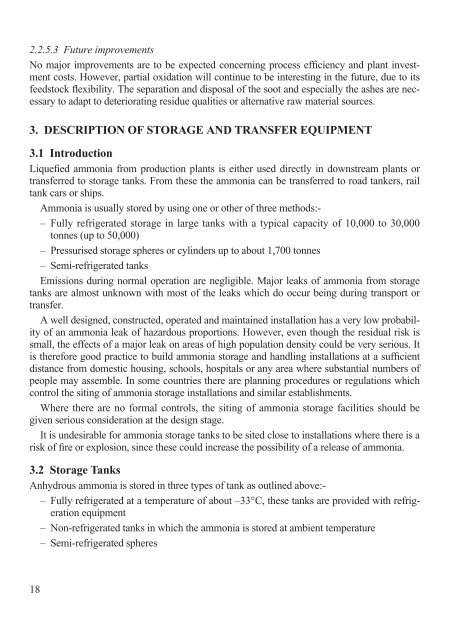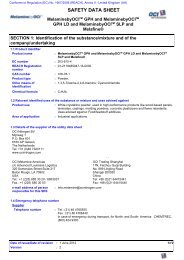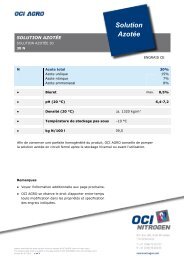PRODUCTION OF AMMONIA - OCI Nitrogen
PRODUCTION OF AMMONIA - OCI Nitrogen
PRODUCTION OF AMMONIA - OCI Nitrogen
You also want an ePaper? Increase the reach of your titles
YUMPU automatically turns print PDFs into web optimized ePapers that Google loves.
2.2.5.3 Future improvements<br />
No major improvements are to be expected concerning process efficiency and plant investment<br />
costs. However, partial oxidation will continue to be interesting in the future, due to its<br />
feedstock flexibility. The separation and disposal of the soot and especially the ashes are necessary<br />
to adapt to deteriorating residue qualities or alternative raw material sources.<br />
3. DESCRIPTION <strong>OF</strong> STORAGE AND TRANSFER EQUIPMENT<br />
3.1 Introduction<br />
Liquefied ammonia from production plants is either used directly in downstream plants or<br />
transferred to storage tanks. From these the ammonia can be transferred to road tankers, rail<br />
tank cars or ships.<br />
Ammonia is usually stored by using one or other of three methods:-<br />
– Fully refrigerated storage in large tanks with a typical capacity of 10,000 to 30,000<br />
tonnes (up to 50,000)<br />
– Pressurised storage spheres or cylinders up to about 1,700 tonnes<br />
– Semi-refrigerated tanks<br />
Emissions during normal operation are negligible. Major leaks of ammonia from storage<br />
tanks are almost unknown with most of the leaks which do occur being during transport or<br />
transfer.<br />
A well designed, constructed, operated and maintained installation has a very low probability<br />
of an ammonia leak of hazardous proportions. However, even though the residual risk is<br />
small, the effects of a major leak on areas of high population density could be very serious. It<br />
is therefore good practice to build ammonia storage and handling installations at a sufficient<br />
distance from domestic housing, schools, hospitals or any area where substantial numbers of<br />
people may assemble. In some countries there are planning procedures or regulations which<br />
control the siting of ammonia storage installations and similar establishments.<br />
Where there are no formal controls, the siting of ammonia storage facilities should be<br />
given serious consideration at the design stage.<br />
It is undesirable for ammonia storage tanks to be sited close to installations where there is a<br />
risk of fire or explosion, since these could increase the possibility of a release of ammonia.<br />
3.2 Storage Tanks<br />
Anhydrous ammonia is stored in three types of tank as outlined above:-<br />
– Fully refrigerated at a temperature of about –33°C, these tanks are provided with refrigeration<br />
equipment<br />
– Non-refrigerated tanks in which the ammonia is stored at ambient temperature<br />
– Semi-refrigerated spheres<br />
18

















